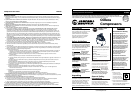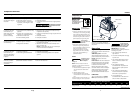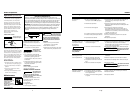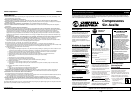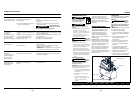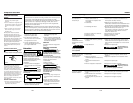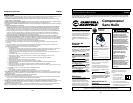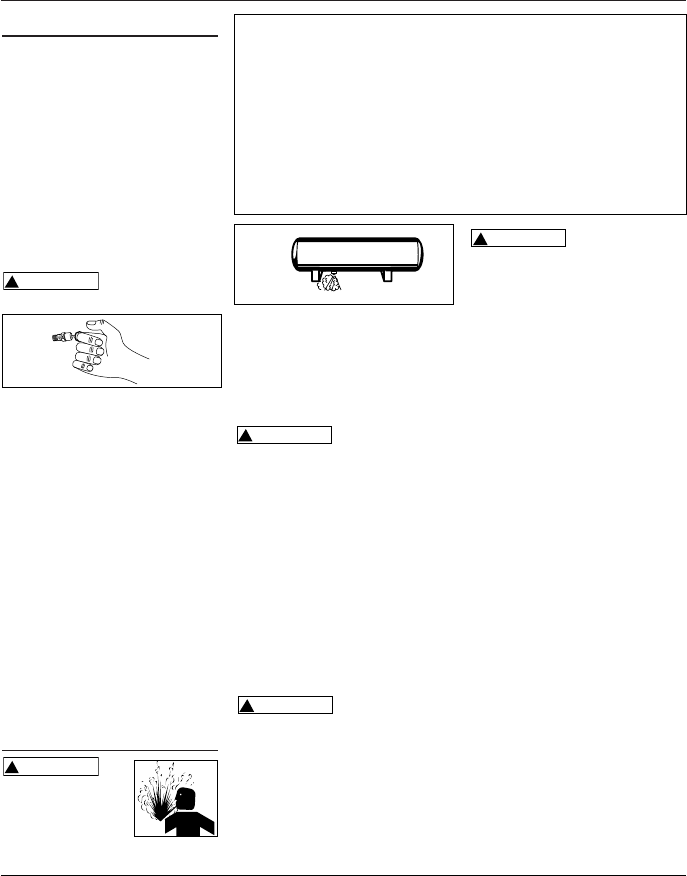
21 Sp
4
Operation (Continued)
7. Attach chuck or other tool to open
end of hose. Turn the regulator on.
In the ON position, the compressor
pumps air into the tank. It shuts off
automatically when unit reaches its
maximum preset pressure. In the OFF
position, the pressure switch cannot
function and the compressor will not
operate. Make sure switch is in OFF
position when connecting or
disconnecting power cord from
electrical outlet.
ASME SAFETY VALVE
Do not remove or
attempt to adjust
the safety valve!
This valve should be checked
occasionally by pulling the ring by
hand. Air may leak even after ring has
been released. However, if the leaking
continues for an extended period of
time, or if the safety valve is stuck and
cannot be activated by the ring, the
safety valve MUST be replaced. (Note:
Valve will reset when tank pressure
reaches 40-50 PSI.)
REGULATOR KNOB
1. This knob controls air pressure to an
air operated tool or paint spray gun.
2. Turn knob clockwise to increase air
pressure.
3. To lower air pressure turn knob
counterclockwise.
4. Turn fully counterclockwise to shut
off flow of air completely.
Maintenance
Disconnect power
source then release all
pressure from the
system before
attempting to install,
service, relocate or perform any
maintenance.
!
WARNING
!
WARNING
Check compressor often for any visible
problems and follow maintenance
procedures each time compressor is
used.
1. Pull ring on safety valve and allow it
to snap back to normal position.
Safety valve must
be replaced if it
cannot be actuated or it leaks air after
ring is released.
2. Turn compressor off and release
pressure from system. Drain moisture
from tank by opening drain cock
underneath tank. Tilt tank to remove
all moisture.
3. Clean dust and dirt from motor, tank,
air lines and pump cooling fins while
compressor is still OFF.
LUBRICATION
This is an oilless type compressor
requiring no lubrication.
THERMAL OVERLOAD PROTECTOR
This compressor is
equipped with an
automatic reset thermal overload
protector which will shut off motor if it
becomes overheated.
If thermal overload protector shuts
motor OFF frequently, look for the
following causes.
1. Low voltage.
2. Clogged air filter.
3. Lack of proper ventilation.
!
CAUTION
!
WARNING
If the thermal
overload protector
is actuated, the motor must be allowed
to cool down before start-up is possible.
The motor will automatically restart
without warning if left plugged into
electrical outlet and unit is turned on.
STORAGE
1. When not in use, store hose and
compressor in a cool dry place.
2. Drain tank of moisture.
3. Disconnect hose and hang open ends
down to allow any moisture to drain.
!
CAUTION
Figure 3
MOISTURE IN COMPRESSED AIR
Moisture in compressed air will form into droplets as it comes from an air
compressor pump. When humidity is high or when a compressor is in continuous
use for an extended period of time, this moisture will collect in the tank. When
using a paint spray or sandblast gun, this water will be carried from the tank
through the hose, and out of the gun as droplets mixed with the spray material.
IMPORTANT: This condensation will cause water spots in a paint job, especially
when spraying other than water based paints. If sandblasting, it will cause the
sand to cake and clog the gun, rendering it ineffective. A filter in the air line
(MP3105), located as near to the gun as possible, will help eliminate this
moisture.
Oilless Compressors
Figure 4
FP2040
Guía de diagnóstico de averías
Problema Posible(s) Causa(s) Acción a tomar
1. No hay corriente eléctrica, o el
interruptor está en OFF (apagado)
2. El fusible está quemado
3. El motor está sobrecargado
4. La presión del tanque está al máximo
5. El cortacircuito (cuchilla) está abierto
6. El presostato está dañado
1. Tamaño incorrecto de fusible,
circuito sobrecargado
2. Válvula de retención defectuosas
1. Bajo voltaje
2. Falta de ventilación adecuada o
temperatura ambiente muy alta
3. Compruebe si la válvula no funciona
bien
4. Fallaron las válvulas del compresor
1. Pernos flojos, tanque no nivelado
2. Cojinete defectuoso en la excéntrica
o en el eje del motor
3. Cilindro o anillo de émbolo gastados
o rayados
1. Cerciórese de que el compresor esté conectado al
tomacorriente y el interruptor esté en ON
(encendido)
2. Desconecte el compresor del tomacorriente y
destape el cabezal. Reemplace el fusible (pieza No.
FP200352AV)
3. Permita que el compresor se enfríe por
aproximadamente 30 minutos de modo que el
dispositivo de sobrecarga térmica se reactive. Si la
unidad aún no se enciende, vacíe el aire del tanque
y regrese a los pasos 1 y 2
4. Libere el aire del tanque
5. Cierre el cortacircuito y determine la causa del
problema
6. Reemplace el preóstato
1. Verifique que el fusible sea el adecuado en el circuito
de alimentación. Desconecte otros artefactos
eléctricos del circuito o haga funcionar el compresor
con su propio circuito derivado
2. Reemplace el ensamblaje de la válvula de chequeo
No desarme la válvula
de retención con aire
en el tanque; purgue el tanque
1. Elimine el cordón de extensión, revise con un
voltímetro
2. Mueva el compresor a una zona bien ventilada
3. Reemplace el ensamblaje de la válvula de chequeo
4. Reemplace cabezal
No desarme la válvula
de retención con aire
en el tanque; purgue el tanque
1. Ajuste los pernos, calce el tanque para nivelarlo
2. Reemplace cabezal
3. Reemplace cabezal
!
PRECAUCION
!
PRECAUCION
El compresor no
funciona
Los fusibles vuelan o el
interruptor de circuito
se desconecta
repetidamente
Nunca use un cordón
de extensión con
este producto
El protector de
sobrecarga térmica se
activa repetidamente
Golpeteos, cascabeleos,
vibración excesiva
!
PRECAUCION
www.chpower.com



